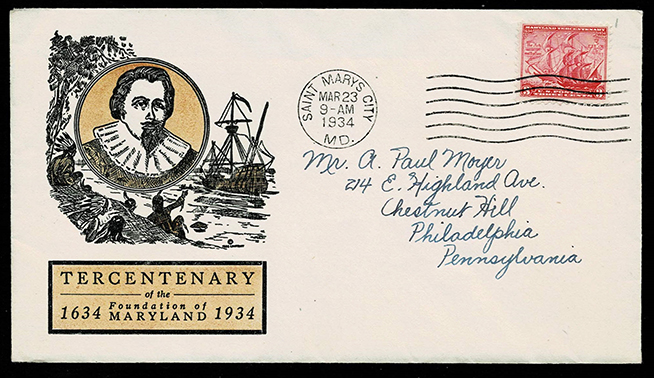
Maryland on Stamps…
Richard D. L. Fulton
Fatty Maschii Parole Femine (Strong Deeds, Gentle Words)
– The motto of the State of Maryland
On March 24, 1934, America celebrated the 300th anniversary of the founding of the colony of Maryland through the issuance by the United States Postal Service of a 3-cent stamp.
First Day of Issue cancellations of the stamps were conducted at the post office in Saint Mary’s City—the first capital of Maryland—and at the Washington, D.C. headquarters of the United States Postal Service. The Saint Mary’s City cancellation is more desirable than the Washington, D.C. cancellation.
The carmine-red stamps depicted the two ships, the Ark and the Dove, that had arrived from England with the first European colonists, who disembarked at Point Comfort near a location that would eventually become Saint Mary’s City.
According to marylanddove.org, the Ark, a three-master (meaning it had the main sails) was described as having a 400-ton cargo capacity, while the Dove, a two-master (meaning it had two main sails) was a small vessel capable of carrying some 40 tons of cargo.
The Ark carried approximately 140 to 150 colonists, comprised of a mix of Catholics and Protestants, and their servants, and the ship’s crew members. The ship was leased by Cecil Calvert for the trip.
It is believed that the Dove was mainly manned by only the crew, according to Chesapeake Magazine, and was, by design, a lighter vessel intended in this instance to be utilized by Calvert to engage in coastal trade.
Not among the passengers aboard the Ark was Cecil (Cecilius) Calvert, who inherited the land that would become Maryland when his father, Geroge Calvert, died in 1632.
King Charles I had granted Calvert’s father a request for a colony in the “New World,” to be called the Province of Maryland, dubbed Terra Mariae. But the charter enabling the act was not consummated until after Calvert’s father’s death, so the charter fell to the survivors, resulting in Cecil Calvert embarking enroute to the Mid-Atlantic Coast of America in order to bring the dream of his father into reality, thereby establishing the colony of Maryland.
According to “Founding of Maryland – Educational Project for Elementary and Middle School Students,” written by Maria A. Day, an archival intern with the Maryland State Archives, “He (Cecil) did not have his father’s years of experience at governing colonies. No one knew what kind of leader Cecil might turn out to be when the king named him Lord Proprietor of Maryland.”
Nevertheless, he elected to remain in England to protect the integrity of his charter, apparently feeling there were those who would seek to repeal this father’s charter. He sent his brother, Leonard, overseas in his place, along with a set of instructions on how to govern the colony, entitled, “Instructions to the Colonists by Lord Baltimore (Cecil held the title of the Second Lord Baltimore, although he had never been there).”
Among the instructions was the intent to ensure that whatever conflicts existed between religions in England stayed in England and assured that “freedom of religion” would become the policy of the colony of Maryland. The instructions would become the basis for Maryland law.
Leonard Calvert, along with Cecil Calvert’s instructions, and 140 to 150 Catholics and Protestants, set sail from the Isle of Wight, England, on November 22, 1633. They arrived in Barbados in January 1633, and then sailed to Point Comfort (Virginia), having arrived there on February 24, 1634.
A month later, the colonists sailed up the Chesapeake Bay and then to one of the Potomac River islands, arriving there on March 25, subsequently establishing Saint Mary’s City, thereby making that community as having been Maryland’s first European settlement and the state’s first capital.
Things remained peaceful in the new colony until 1645 when a force commanded by anti-Catholic Richard Ingle attacked Saint Mary’s City, taking a number of prisoners, while Leonard Calvert was forced to flee to Virginia for nearly a year, according to the Maryland State Archives.

First Day Cover of Maryland Tercentenary stamp, cancelled March 23, 1934, at Saint Mary’s City.
